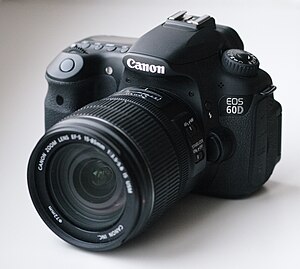The Canon EOS 60D is an 18.1 megapixels semi-pro digital single-lens reflex camera made by Canon. It was announced on August 26, 2010, with a suggested retail price of US$1099.00.[1] As a part of the Canon EOS two-digit line, it is the successor of the EOS 50D and is the predecessor of the EOS 70D.
 | |
| Overview | |
|---|---|
| Type | Digital single-lens reflex camera |
| Intro price | US$1099.00[1] |
| Lens | |
| Lens | Interchangeable (EF / EF-S) |
| Sensor/medium | |
| Sensor type | CMOS |
| Sensor size | 22.3 × 14.9 mm (APS-C format) |
| Maximum resolution | 5184 × 3456 pixels (4.3 μm pixel size)[2] (18.1 effective megapixels) |
| Film speed | 100 – 6400 (expandable to H: 12800) |
| Storage media | SD/SDHC/SDXC (Does not exploit UHS-I bus) |
| Focusing | |
| Focus modes | One-Shot, AI Focus, AI Servo, Live View (FlexiZone - Multi, FlexiZone - Single, Face detection, AF Quick) |
| Focus areas | 9 cross-type AF points |
| Exposure/metering | |
| Exposure modes | Full Auto, Flash Off, Creative Auto, Portrait, Landscape, Close-up, Sports, Night Portrait, Program AE, Shutter priority AE, Aperture priority AE, Manual exposure, Bulb exposure, Custom, Movie |
| Exposure metering | Full aperture TTL, 63 zones iFCL SPC |
| Metering modes | Evaluative, Partial, Spot, Centre-weighted Average |
| Flash | |
| Flash | E-TTL II auto-pop-up built-in / External |
| Flash bracketing | N/A |
| Shutter | |
| Shutter | Electronic focal-plane |
| Shutter speed range | 1/8000 sec. – 30 sec. and Bulb; X-sync at 1/250 sec. |
| Continuous shooting | Up to 5.3 fps |
| Viewfinder | |
| Viewfinder | Eye-level pentaprism with 96% coverage and 0.95x magnification / LCD (Live View) |
| Image processing | |
| Image processor | DIGIC 4 |
| White balance | Auto, Daylight, Shade, Cloudy, Tungsten, White Fluorescent, Flash, Custom, Kelvin (2500 - 10000K in 100K steps) |
| General | |
| LCD screen | 3.0" (7.7 cm) Clear View II colour LCD screen with 1,040,000 dots resolution |
| Battery | Li-Ion LP-E6 rechargeable (1800 mAh) |
| Optional battery packs | BG-E9 grip allows the use of 6 AA cells, one LP-E6 battery or two LP-E6 batteries |
| Dimensions | 144.5 mm × 105.8 mm × 78.6 mm (5.69 in × 4.17 in × 3.09 in) |
| Weight | 755 g (26.6 oz) |
| Made in | Japan |
| Chronology | |
| Predecessor | Canon EOS 50D |
| Successor | Canon EOS 70D |
It is the first Canon EOS camera which has an articulating LCD screen. Apart from its screen, the main new features of the 60D in the two-digit Canon line include increased resolution and ISO range, full-HD video capabilities, and in-camera post-processing functions for the images. However, it uses the DIGIC 4 image processor.
Like the 50D, the camera has an LCD of settings on the top of the camera where the ISO, AF-Mode, Shooting mode, and metering mode can be controlled.
The 60D is offered for purchase as a body alone or in a package with an EF-S 18-200mm f/3.5-5.6 IS lens, EF-S 17–85mm f/4-5.6 IS USM lens, EF-S 18–135mm f/3.5-5.6 IS lens, EF-S 17-55mm f/2.8 IS USM lens, or an EF-S 18–55mm f/3.5–5.6 lens
Compared to the EOS 50D, the following changes have been made, including:
Digital Photography Review described the changes as representing the move from 'semi-pro'/'prosumer' to 'enthusiast'[3] due to the reduction in some features; however the pentaprism viewfinder and iconic rear control wheel remain, as does the top informational LCD. The slightly smaller body retains the grip of the two-digit Canon line.[4]
Canon announced a modified version of the EOS 60D for astrophotography on April 3, 2012, called the EOS 60Da. The 60Da is the successor to the EOS 20Da. It was expected to cost $1,499.[5] The camera has a modified infrared filter and a low-noise sensor with heightened hydrogen-alpha (H-alpha) sensitivity for improved capture of red hydrogen emission nebulae.[6] The 60Da is three times as sensitive to H-alpha light as the 60D to allow for better images of nebulae.[7]